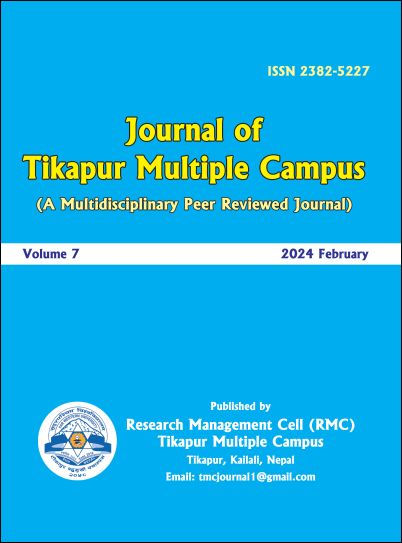Assessing Growth, Productivity, Profitability and Yield Gaps of Spring Maize Using Site Specific Nutrient Management Approaches in Kailali
DOI:
https://doi.org/10.3126/jotmc.v7i1-2.63202Keywords:
Growth, productivity, profitability and yield gaps, site-specific nutrient management, sub-tropical Far Western TeraiAbstract
A field experiment was conducted during spring season of 2023 at the sub-tropical climate of Tikapur, Kailali to evaluate the impact of site-specific nutrient management on growth, productivity, profitability and yield gaps of spring maize. The experiment followed a Randomized Complete Block Design (RCBD) with six treatment combinations and four replications. Maize seeds were sown in four different farms on 27 February, 2023 with different site-specific nutrient management (SSNM) approaches viz. with Nutrient Expert®-Maize recommended dose (T1), three omission plots i.e., Omission of Nitrogen (T2), Omission of Phosphorus (T3), Omission of Potassium (T4), Government Recommended Dose (T5), and Farmer’s Fertilizer Practices (T6). Using the Nutrient Expert® Maize model Computer Software, the SSNM+NE dose was recommended via a household survey in the respective farmer's field before the start-up of the experimentation. Various growth parameters, yield, yield attributing traits, and total cost of production of spring maize were recorded and subjected to analysis using Duncan's Multiple Range Test (DMRT) in R-studio. The results revealed that the highest grain yield (3.71 t ha-1) was achieved with SSNM+NE, which was statistically at par with the Government Recommendation Dose (3.12 t ha-1). Moreover, SSNM+NE showed significantly higher thousand grains weight (442.75 g) and straw yield (6.81 t ha-1), respectively. Notably, the straw yield, grain yield, and thousand grain weight of SSNM+NE were statistically comparable to those obtained with the government recommendation. Economic analysis showed higher benefit-cost ratio as well as increased net and gross returns in SSNM+NE as compared to the other nutrient management practices. The SSNM+NE and Governmental Recommended Fertilizer based treatments were about 231% and 178% advantageous over the Farmer’s Fertilizer Practices. It could be suggested that SSNM+NE would the best approach for increasing the growth, productivity and profitability of spring maize in the sub-tropical terai of Far Western Nepal.
Downloads
Downloads
Published
How to Cite
Issue
Section
License

This work is licensed under a Creative Commons Attribution-NonCommercial 4.0 International License.
This license enables reusers to distribute, remix, adapt, and build upon the material in any medium or format, so long as attribution is given to the creator. The license allows for commercial use.




